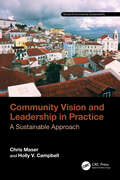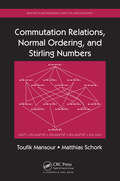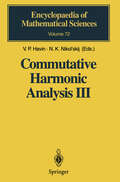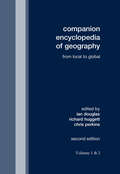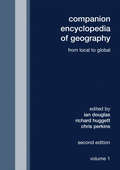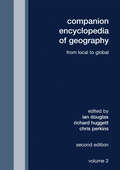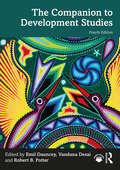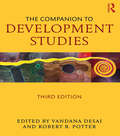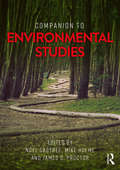- Table View
- List View
Community Seed Banks: Origins, Evolution and Prospects (Issues in Agricultural Biodiversity)
by Ronnie Vernooy Pitambar Shrestha Bhuwon SthapitCommunity seed banks first appeared towards the end of the 1980s, established with the support of international and national non-governmental organizations. This book is the first to provide a global review of their development and includes a wide range of case studies. Countries that pioneered various types of community seed banks include Bangladesh, Brazil, Ethiopia, India, Nepal, Nicaragua, the Philippines and Zimbabwe. In the North, a particular type of community seed bank emerged known as a seed-savers network. Such networks were first established in Australia, Canada, the UK and the USA before spreading to other countries. Over time, the number and diversity of seed banks has grown. In Nepal, for example, there are now more than 100 self-described community seed banks whose functions range from pure conservation to commercial seed production. In Brazil, community seed banks operate in various regions of the country. Surprisingly, despite 25 years of history and the rapid growth in number, organizational diversity and geographical coverage of community seed banks, recognition of their roles and contributions has remained scanty. The book reviews their history, evolution, experiences, successes and failures (and reasons why), challenges and prospects. It fills a significant gap in the literature on agricultural biodiversity and conservation, and their contribution to food sovereignty and security.
Community Seed Banks: Origins, Evolution and Prospects (Issues in Agricultural Biodiversity)
by Ronnie Vernooy Pitambar Shrestha Bhuwon SthapitCommunity seed banks first appeared towards the end of the 1980s, established with the support of international and national non-governmental organizations. This book is the first to provide a global review of their development and includes a wide range of case studies. Countries that pioneered various types of community seed banks include Bangladesh, Brazil, Ethiopia, India, Nepal, Nicaragua, the Philippines and Zimbabwe. In the North, a particular type of community seed bank emerged known as a seed-savers network. Such networks were first established in Australia, Canada, the UK and the USA before spreading to other countries. Over time, the number and diversity of seed banks has grown. In Nepal, for example, there are now more than 100 self-described community seed banks whose functions range from pure conservation to commercial seed production. In Brazil, community seed banks operate in various regions of the country. Surprisingly, despite 25 years of history and the rapid growth in number, organizational diversity and geographical coverage of community seed banks, recognition of their roles and contributions has remained scanty. The book reviews their history, evolution, experiences, successes and failures (and reasons why), challenges and prospects. It fills a significant gap in the literature on agricultural biodiversity and conservation, and their contribution to food sovereignty and security.
Community Seed Production Sustainability in Rice-Wheat Farming
by Narayan Prasad Khanal Keshav Lall MaharjanThis book analyzes the sustainability of community seed production under a rice–wheat farming system from microeconomic perspectives, considering how seed producers benefit from community seed production and how those benefits continue into the future. Seed producers’ performance in resource management, governance and marketing strategies indicates current benefits, whereas soil conservation and risk-management practices provide the basis for future benefits. Community seed production is a local-level seed management system owned by farmers. This system provides the institutional mechanism to supply diversified seed demands of open-pollinated varieties of food crops in a cost-effective way in rural regions. Being able to address the concerns of food insecurity, poverty, climate stress and biodiversity loss in programs and policies of development agencies, community seed production is gaining popularity among the farmers and the policy makers in developing countries.This book discusses the issues of organizational governance of the community seed producers’ groups and links them with household-level benefits to understand the organizational dynamism and the probable development paths of such organizations in the future. It also highlights the necessity to institutionalize lessons learned in community seed production in the stakeholders’ programs and policies. These understandings provide a basis for formulating policies for strengthening the system in developing countries. Students, researchers, policy makers and donor agencies working with CSP in the developing world will find this book useful in broadening their understanding of CSP in general and its sustainability in particular.
Community Vision and Leadership in Practice: A Sustainable Approach (Social-Environmental Sustainability)
by Chris Maser Holly V. CampbellThis book is about building and maintaining involved, sustainable, and inclusive communities from the ground up during a period of unprecedented growth and global change. It explains the concepts and principles of community and sustainability and provides students with a framework of sustainable community planning to put into practice. It is also designed to help communities everywhere identify and reconnect the true essence of their ecological setting with the objective of raising their quality of life by increasing social, environmental, and economic sustainability. Features: Provides up-to-date frameworks for sustainable community planning processes and case studies on community planning Explains tools for sustainable planning in accessible (non-specialist) language Illustrates a roadmap to an inclusive, collaborative future Explains aspects of sustainable community planning to maximize ecological ecosystem services and climate co-benefits simultaneously Includes discussion questions and suggestions following each chapter Intended for undergraduate and graduate students taking leadership and community courses with an emphasis on sustainable practices and ethics, as well as for citizens and professionals involved in community projects related to sustainability, the authors provide a forward-thinking approach, showing readers that they are capable of making a positive impact on the future of community development through sustainable approaches and ethical leadership practices.
Community Vision and Leadership in Practice: A Sustainable Approach (Social-Environmental Sustainability)
by Chris Maser Holly V. CampbellThis book is about building and maintaining involved, sustainable, and inclusive communities from the ground up during a period of unprecedented growth and global change. It explains the concepts and principles of community and sustainability and provides students with a framework of sustainable community planning to put into practice. It is also designed to help communities everywhere identify and reconnect the true essence of their ecological setting with the objective of raising their quality of life by increasing social, environmental, and economic sustainability. Features: Provides up-to-date frameworks for sustainable community planning processes and case studies on community planning Explains tools for sustainable planning in accessible (non-specialist) language Illustrates a roadmap to an inclusive, collaborative future Explains aspects of sustainable community planning to maximize ecological ecosystem services and climate co-benefits simultaneously Includes discussion questions and suggestions following each chapter Intended for undergraduate and graduate students taking leadership and community courses with an emphasis on sustainable practices and ethics, as well as for citizens and professionals involved in community projects related to sustainability, the authors provide a forward-thinking approach, showing readers that they are capable of making a positive impact on the future of community development through sustainable approaches and ethical leadership practices.
Community Well-Being and Community Development: Conceptions and Applications (SpringerBriefs in Well-Being and Quality of Life Research #0)
by Seung Jong Lee Yunji Kim Rhonda PhillipsThis briefs provides foundations of both community wellbeing and community development, and the relationships between the two areas, including both similarities and differences. Community well-being encompasses a large array of concepts and disciplines. Community development, as an established discipline, is one framework that can help further understanding of community well-being, and is an allied concept. The interaction between the two areas is worthy of exploration, as both a new way to think about community development as well as a way to understand what community well-being entails. Beginning with a discussion of the foundations, the first and second chapters provide grounding for conceptions and potential theory applications as well as constructs for moving community wellbeing forward. The remaining chapters provide applications of community well-being in the context of community development, with examples from North America and Asia. Community development focused community wellbeing policies and programs illustrate processes and outcomes.
Commutation Relations, Normal Ordering, and Stirling Numbers
by Toufik Mansour Matthias SchorkCommutation Relations, Normal Ordering, and Stirling Numbers provides an introduction to the combinatorial aspects of normal ordering in the Weyl algebra and some of its close relatives. The Weyl algebra is the algebra generated by two letters U and V subject to the commutation relation UV - VU = I. It is a classical result that normal ordering pow
Commutative Harmonic Analysis III: Generalized Functions. Application (Encyclopaedia of Mathematical Sciences #72)
by V. S. Buslaev V. P. Havin B. Jöricke V. P. PalamodovAimed at readers who have learned the principles of harmonic analysis, this book provides a variety of perspectives on this very important classical subject. The authors have written a truly outstanding book which distinguishes itself by its excellent expository style.
Compact Slot Array Antennas for Wireless Communications (Signals and Communication Technology)
by Alan J. SangsterThis book describes and provides design guidelines for antennas that achieve compactness by using the slot radiator as the fundamental building block within a periodic array, rather than a phased array. It provides the basic electromagnetic tools required to design and analyse these novel antennas, with sample calculations where relevant. The book presents a focused introduction and valuable insights into the relevant antenna technology, together with an overview of the main directions in the evolving technology of compact planar arrays. While the book discusses the historical evolution of compact array antennas, its main focus is on summarising the extensive body of literature on compact antennas. With regard to the now ubiquitous slot radiator, it seeks to demonstrate how, despite significant antenna size reductions that at times even seem to defy the laws of physics, desirable radiation pattern properties can be preserved. This is supported by an examination of recent advances in frequency selective surfaces and in metamaterials, which can, if handled correctly, be used to facilitate physics-defying designs. The book offers a valuable source of information for communication systems and antenna design engineers, especially thanks to its overview of trends in compact planar arrays, yet will also be of interest to students and researchers, as it provides a focused introduction and insights into this highly relevant antenna technology.
Companies on a Mission: Entrepreneurial Strategies for Growing Sustainably, Responsibly, and Profitably
by Michael V. Russo"Let your social and environmental conscience be your guide" can be a successful and durable strategy for a firm. This is the first book to explain how following a vision for the earth and for society can be a powerful route to profits for small and medium sized companies. Companies on a Mission explains that mission-driven companies appreciate and leverage traditional strategic principles—with a twist—to win in the marketplace. By clearly and pragmatically laying out this argument, author Michael V. Russo crystallizes for enlightened businesses what Michael Porter made clear for mainstream firms years ago. The book shows that a mission-driven approach creates significant barriers to imitation by larger, established rivals. Mission-driven firms build their brands on authenticity. Only you are you. And, authenticity builds customer loyalty. Later in the book, Russo moves beyond the firm level to look at these companies in context. He finds, for instance, that just as specific industries often develop in geographic clusters, mission-driven companies also aggregate. But, they put down roots where other businesses are pursuing complementary goals. Portland and the Bay Area are two such hotbeds. This allows for cooperation, as opposed to breeding stiff competition. The rise to prominence of mission-driven companies like Patagonia, Seventh Generation, Kettle Foods, and Calvert Group is undoubtedly the result of powerful trends in consumer markets, including the rise of conscious consumerism, the transparency movement, and fallout from global competition. Most books that address social and environmental issues are focused on large corporations, crafted as autobiographies by CEOs, or written as moral calls to action without regard for the bottom line. Companies on a Mission both chronicles a movement and provides grounded guidance to entrepreneurs and managers who wish to join the wave. For these readers, this book is a one-of-a-kind bible.
Companies that Mimic Life: Leaders of the Emerging Corporate Renaissance
by Joseph H. BragdonIndustrial capitalism is broken. The signs, which transcend national ideologies, are everywhere: climate change; ecological overshoot; financial exhaustion; fraying social safety nets; corporate fraud; government deceit; civic unrest; terrorism; and war. But there is hope. This book tells how transformation is taking root in the corporate world – the last place many of us would look for solutions. The book tells the stories of seven exceptional companies. Their shared secret is a new mental model of the firm that is the virtual opposite of industrial capitalism. Each company, if not already a household name, is a significant player within their industry and, crucially, has outperformed their competitors. Lessons can be learned. It works like this. Instead of modeling themselves on the assumed efficiency of machines – a thought process that emerged during the industrial age – these firms model themselves on living systems. Firms with open, ethical, inclusive traditions – where employees have a voice and a stake in what happens – have a distinct advantage over traditionally managed companies where most decisions are made at the top. Understanding that everything of value ultimately arises from life, they place a higher value on living assets (people and Nature) than they do on non-living capital assets. The energy they invest in stewarding those assets – a practice described in the book as living asset stewardship (LAS) – is transformative.
Companies that Mimic Life: Leaders of the Emerging Corporate Renaissance
by Joseph H. BragdonIndustrial capitalism is broken. The signs, which transcend national ideologies, are everywhere: climate change; ecological overshoot; financial exhaustion; fraying social safety nets; corporate fraud; government deceit; civic unrest; terrorism; and war. But there is hope. This book tells how transformation is taking root in the corporate world – the last place many of us would look for solutions. The book tells the stories of seven exceptional companies. Their shared secret is a new mental model of the firm that is the virtual opposite of industrial capitalism. Each company, if not already a household name, is a significant player within their industry and, crucially, has outperformed their competitors. Lessons can be learned. It works like this. Instead of modeling themselves on the assumed efficiency of machines – a thought process that emerged during the industrial age – these firms model themselves on living systems. Firms with open, ethical, inclusive traditions – where employees have a voice and a stake in what happens – have a distinct advantage over traditionally managed companies where most decisions are made at the top. Understanding that everything of value ultimately arises from life, they place a higher value on living assets (people and Nature) than they do on non-living capital assets. The energy they invest in stewarding those assets – a practice described in the book as living asset stewardship (LAS) – is transformative.
Companion Encyclopedia of Geography: From the Local to the Global
by Ian Douglas Richard Huggett Chris PerkinsThis revised edition takes the theme of place as the unifying principle for a full account of the discipline at the beginning of the twenty-first century.The work comprises 64 substantial essays addressing human and physical geography, and exploring their inter-relations. The encyclopedia does full justice to the enormous growth of social and cultural geography in recent years. Leading international academics from ten countries and four continents have contributed, ensuring that differing traditions in geography around the world are represented. In addition to references, the essays also have recommendations for further reading. As with the original work, the new Companion Encyclopedia of Geography provides a state-of-the-art survey of the discipline and is an indispensable addition to the reference shelves of libraries supporting research and teaching in geography.
Companion Encyclopedia of Geography: From the Local to the Global
by Ian Douglas Richard Huggett Chris PerkinsThis revised edition takes the theme of place as the unifying principle for a full account of the discipline at the beginning of the twenty-first century.The work comprises sixty-four substantial essays addressing human and physical geography, and exploring their inter-relations. The Encyclopedia does full justice to the enormous growth of social and cultural geography in recent years. Leading international academics from ten countries and four continents have contributed, ensuring that differing traditions in geography around the world are represented. In addition to references, the essays also have recommendations for further reading. As with the original work, the new Companion Encyclopedia of Geography provides a state-of-the-art survey of the discipline and is an indispensable addition to the reference shelves of libraries supporting research and teaching in geography.
Companion Encyclopedia of Geography: From the Local to the Global
by Ian Douglas Richard Huggett Chris PerkinsThis revised edition takes the theme of place as the unifying principle for a full account of the discipline at the beginning of the twenty-first century.The work comprises sixty-four substantial essays addressing human and physical geography, and exploring their inter-relations. The Encyclopedia does full justice to the enormous growth of social and cultural geography in recent years. Leading international academics from ten countries and four continents have contributed, ensuring that differing traditions in geography around the world are represented. In addition to references, the essays also have recommendations for further reading. As with the original work, the new Companion Encyclopedia of Geography provides a state-of-the-art survey of the discipline and is an indispensable addition to the reference shelves of libraries supporting research and teaching in geography.
Companion Encyclopedia of Geography: From the Local to the Global
by Ian Douglas Richard Huggett Chris PerkinsThis revised edition takes the theme of place as the unifying principle for a full account of the discipline at the beginning of the twenty-first century.The work comprises 64 substantial essays addressing human and physical geography, and exploring their inter-relations. The encyclopedia does full justice to the enormous growth of social and cultural geography in recent years. Leading international academics from ten countries and four continents have contributed, ensuring that differing traditions in geography around the world are represented. In addition to references, the essays also have recommendations for further reading. As with the original work, the new Companion Encyclopedia of Geography provides a state-of-the-art survey of the discipline and is an indispensable addition to the reference shelves of libraries supporting research and teaching in geography.
Companion Encyclopedia of Geography: From the Local to the Global
by Ian Douglas Richard Huggett Chris PerkinsThis revised edition takes the theme of place as the unifying principle for a full account of the discipline at the beginning of the twenty-first century.The work comprises 64 substantial essays addressing human and physical geography, and exploring their inter-relations. The encyclopedia does full justice to the enormous growth of social and cultural geography in recent years. Leading international academics from ten countries and four continents have contributed, ensuring that differing traditions in geography around the world are represented. In addition to references, the essays also have recommendations for further reading. As with the original work, the new Companion Encyclopedia of Geography provides a state-of-the-art survey of the discipline and is an indispensable addition to the reference shelves of libraries supporting research and teaching in geography.
The Companion to Development Studies
by Vandana Desai Robert B. Potter Emil DaunceyThe Companion to Development Studies is essential reading in the field of development studies. This indispensable resource offers succinct, up-to-date, and insightful chapters that reflect the diverse voices and perspectives informing the field and the dynamic interplay of theory, policy, and practice that characterises it.This fourth edition brings together contributions from an impressive range of renowned international experts and emerging voices at the forefront of development studies to deliver engaging, interdisciplinary, and provocative insights into this challenging field. The 98 chapters spanning both theory and practice offer readers accessible discussions of the core issues, emerging trends, and key debates of the discipline. Divided into nine sections of: theories and their contentions; histories and discourses of development; actors and institutions; identities and practices; people and the planet; the economics of development; conflict, violence, and peace; the changing landscape of development; and approaches to policy and practice; this timely new text provides easy to use summaries of all the major issues encountered in this rapidly growing and changing field.The Companion serves students and scholars across various disciplines, including development studies, geography, politics, international relations, sociology, anthropology, and economics. It offers incisive analysis and critical insights, equipping those working in development policy and practice with the knowledge and understanding they need to navigate and address contemporary global challenges.This textbook is supported by flexible, online resources for teaching and learning such as tutorial guides, key concept videos, and a filmography.
The Companion to Development Studies
by Vandana Desai Robert B. Potter Emil DaunceyThe Companion to Development Studies is essential reading in the field of development studies. This indispensable resource offers succinct, up-to-date, and insightful chapters that reflect the diverse voices and perspectives informing the field and the dynamic interplay of theory, policy, and practice that characterises it.This fourth edition brings together contributions from an impressive range of renowned international experts and emerging voices at the forefront of development studies to deliver engaging, interdisciplinary, and provocative insights into this challenging field. The 98 chapters spanning both theory and practice offer readers accessible discussions of the core issues, emerging trends, and key debates of the discipline. Divided into nine sections of: theories and their contentions; histories and discourses of development; actors and institutions; identities and practices; people and the planet; the economics of development; conflict, violence, and peace; the changing landscape of development; and approaches to policy and practice; this timely new text provides easy to use summaries of all the major issues encountered in this rapidly growing and changing field.The Companion serves students and scholars across various disciplines, including development studies, geography, politics, international relations, sociology, anthropology, and economics. It offers incisive analysis and critical insights, equipping those working in development policy and practice with the knowledge and understanding they need to navigate and address contemporary global challenges.This textbook is supported by flexible, online resources for teaching and learning such as tutorial guides, key concept videos, and a filmography.
The Companion to Development Studies, Third Edition
by Vandana Desai Rob PotterThe Companion to Development Studies contains over a hundred chapters written by leading international experts within the field to provide a concise and authoritative overview of the key theoretical and practical issues dominating contemporary development studies. Covering a wide range of disciplines the book is divided into ten sections, each prefaced by a section introduction written by the editors. The sections cover: the nature of development, theories and strategies of development, globalization and development, rural development, urbanization and development, environment and development, gender, health and education, the political economy of violence and insecurity, and governance and development. This third edition has been extensively updated and contains 45 new contributions from leading authorities, dealing with pressing contemporary issues such as race and development, ethics and development, BRICs and development, global financial crisis, the knowledge based economy and digital divide, food security, GM crops, comparative urbanism, cities and crime, energy, water hydropolitics, climate change, disability, fragile states, global war on terror, ethnic conflict, legal rights to development, ecosystems services for development, just to name a few. Existing chapters have been thoroughly revised to include cutting-edge developments, and to present updated further reading and websites. The Companion to Development Studies presents concise overviews providing a gateway to further reading and a flexible resource for teaching and learning. It has established a role as essential reading for all students of development studies, as well as those in cognate areas of geography, international relations, politics, sociology, anthropology and economics.
The Companion to Development Studies, Third Edition
by Vandana Desai Rob PotterThe Companion to Development Studies contains over a hundred chapters written by leading international experts within the field to provide a concise and authoritative overview of the key theoretical and practical issues dominating contemporary development studies. Covering a wide range of disciplines the book is divided into ten sections, each prefaced by a section introduction written by the editors. The sections cover: the nature of development, theories and strategies of development, globalization and development, rural development, urbanization and development, environment and development, gender, health and education, the political economy of violence and insecurity, and governance and development. This third edition has been extensively updated and contains 45 new contributions from leading authorities, dealing with pressing contemporary issues such as race and development, ethics and development, BRICs and development, global financial crisis, the knowledge based economy and digital divide, food security, GM crops, comparative urbanism, cities and crime, energy, water hydropolitics, climate change, disability, fragile states, global war on terror, ethnic conflict, legal rights to development, ecosystems services for development, just to name a few. Existing chapters have been thoroughly revised to include cutting-edge developments, and to present updated further reading and websites. The Companion to Development Studies presents concise overviews providing a gateway to further reading and a flexible resource for teaching and learning. It has established a role as essential reading for all students of development studies, as well as those in cognate areas of geography, international relations, politics, sociology, anthropology and economics.
A Companion to Economic Geography (Wiley Blackwell Companions to Geography)
by Eric SheppardA Companion to Economic Geography presents students of human geography with an essential collection of original essays providing a key to understanding this important subdiscipline. The contributions are written by prominent international scholars offering a wide-ranging overview of the field. Places economic geography in the wider context of geography. Contributions from leading international scholars in the field. Presents a comprehensive, up-to-date and accessible overview of all the major themes in the field. Explores key debates, controversies and questions using a variety of historical and theoretical vantage points. Charts the important work that has been done in recent years and looks forward to new developments in the global economy.
Companion to Environmental Studies
by Noel Castree Mike Hulme James D. ProctorCompanion to Environmental Studies presents a comprehensive and interdisciplinary overview of the key issues, debates, concepts, approaches and questions that together define environmental studies today. The intellectually wide-ranging volume covers approaches in environmental science all the way through to humanistic and post-natural perspectives on the biophysical world. Though many academic disciplines have incorporated studying the environment as part of their curriculum, only in recent years has it become central to the social sciences and humanities rather than mainly the geosciences. ‘The environment’ is now a keyword in everything from fisheries science to international relations to philosophical ethics to cultural studies. The Companion brings these subject areas, and their distinctive perspectives and contributions, together in one accessible volume. Over 150 short chapters written by leading international experts provide concise, authoritative and easy-to-use summaries of all the major and emerging topics dominating the field, while the seven part introductions situate and provide context for section entries. A gateway to deeper understanding is provided via further reading and links to online resources. Companion to Environmental Studies offers an essential one-stop reference to university students, academics, policy makers and others keenly interested in ‘the environmental question’, the answer to which will define the coming century.
Companion to Environmental Studies
by Mike Hulme Noel Castree James D. ProctorCompanion to Environmental Studies presents a comprehensive and interdisciplinary overview of the key issues, debates, concepts, approaches and questions that together define environmental studies today. The intellectually wide-ranging volume covers approaches in environmental science all the way through to humanistic and post-natural perspectives on the biophysical world. Though many academic disciplines have incorporated studying the environment as part of their curriculum, only in recent years has it become central to the social sciences and humanities rather than mainly the geosciences. ‘The environment’ is now a keyword in everything from fisheries science to international relations to philosophical ethics to cultural studies. The Companion brings these subject areas, and their distinctive perspectives and contributions, together in one accessible volume. Over 150 short chapters written by leading international experts provide concise, authoritative and easy-to-use summaries of all the major and emerging topics dominating the field, while the seven part introductions situate and provide context for section entries. A gateway to deeper understanding is provided via further reading and links to online resources. Companion to Environmental Studies offers an essential one-stop reference to university students, academics, policy makers and others keenly interested in ‘the environmental question’, the answer to which will define the coming century.
A Companion to Feminist Geography (Wiley Blackwell Companions to Geography)
by Lise Nelson Joni SeagerA Companion to Feminist Geography captures the breadth and diversity of this vibrant and substantive field. Shows how feminist geography has changed the landscape of geographical inquiry and knowledge since the 1970s. Explores the diverse literatures that comprise feminist geography today. Showcases cutting-edge research by feminist geographers. Charts emerging areas of scholarship, such as the body and the nation. Contributions from 50 leading international scholars in the field. Each chapter can be read for its own distinctive contribution.


